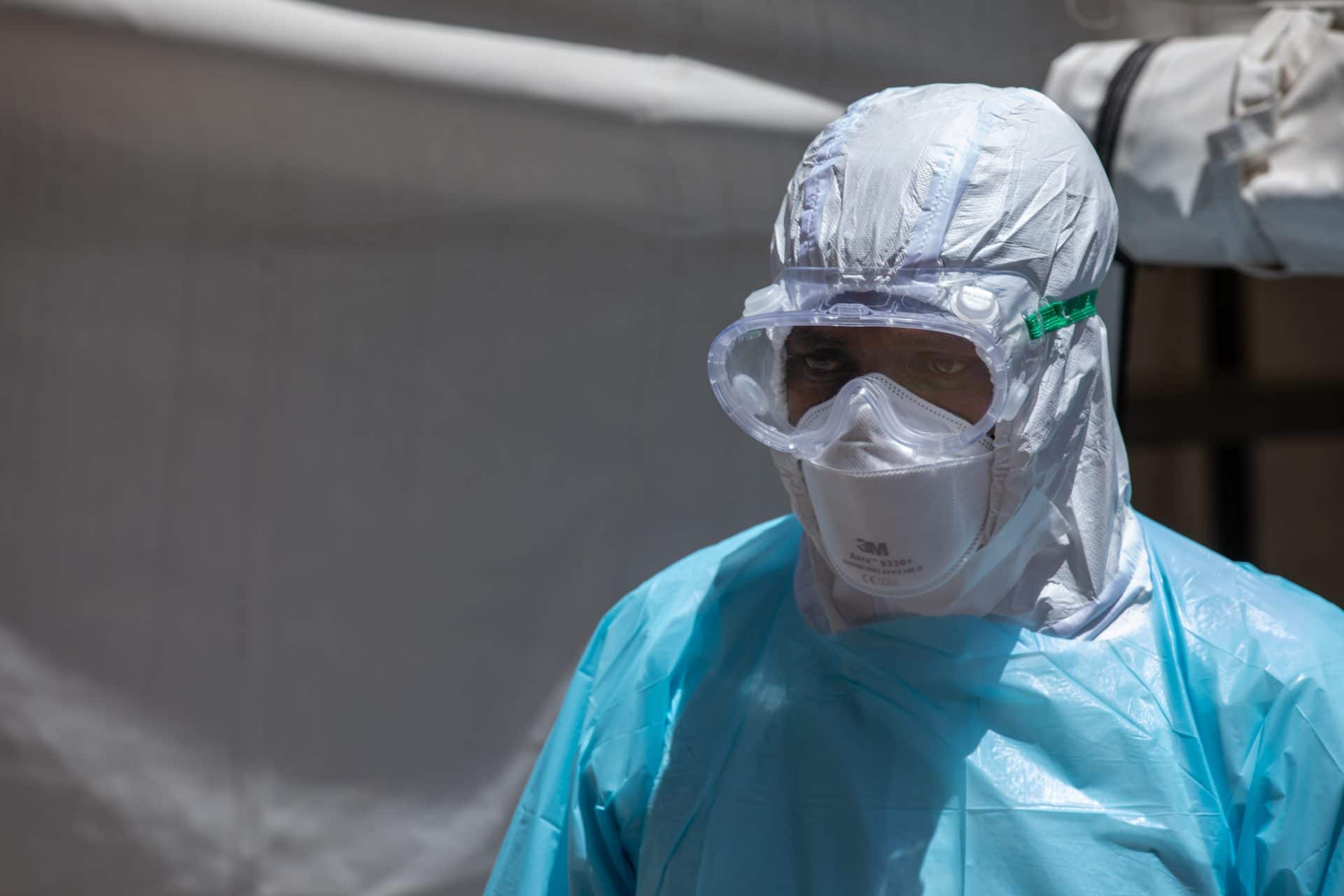The origin of COVID-19: Evidence piles up, but the jury’s still out

A health care worker in personal protective equipment prepares to treat a suspected COVID-19 patient. Credit: UNICEF Ethiopia/2020/Mulugeta Ayene. CC BY-NC 2.0.
It’s been more than 600 days since the Wuhan Municipal Health Commission reported a “cluster of pneumonia of unknown etiology,” almost 200 days since the WHO issued a major report on the origins of COVID-19, and more than a month since the Biden administration in the United States released an inconclusive intelligence review on that issue. Yet, despite the many investigations, studies, and scientific debates on how COVID-19 emerged, cold, hard evidence for how people started getting sick in Wuhan in 2019 remains elusive.
Circumstantial evidence, on the other hand, is piling up. Judgements about whether that circumstantial evidence points more toward one of two general theories of the pandemic’s origin—a natural spillover from an animal reservoir versus a leak from a laboratory studying coronaviruses—seems, at this point, to depend on the judger.
Broadly, there’s a growing body of new research and analysis showing how common spillover of animal coronaviruses may be. New research has also identified viruses in nature with striking similarity to SARS-CoV-2, the virus that causes COVID-19. At the same time, a group of online sleuths found and leaked to the press a major grant proposal from 2018 that demonstrates the high-level of interest researchers, including those in Wuhan, had in manipulating bat coronaviruses, suggesting to some that such work could indeed have played a role in causing the pandemic.
On the one hand, the scientists advocating a natural origin for the pandemic can point to the tens of thousands of wild animals that were being sold in Wuhan, including at the Huanan seafood market where many of the initial cases of COVID-19 were reported. A study published over the summer documented that vendors there were illegally selling a variety of wildlife, including mammals such as raccoon dogs, which can carry and transmit the COVID-19 virus. Raccoon dogs are a potential intermediate host for the virus that caused an outbreak of severe acute respiratory syndrome (SARS) in the early 2000s, an event that many see as having been a preview of the COVID-19 pandemic. The study found that animals were frequently “sold alive, caged, stacked and in poor condition.”
During a recent panel discussion hosted by Science magazine, Michael Worobey, an evolutionary biologist at the University of Arizona, said that those who believe the pandemic may have begun with a lab accident have to grapple with a seeming contradiction: “You face this fundamental issue of, if it started with research, why does it look like it actually started at one of these markets selling these animals that were implicated in the first SARS outbreak”?
In Laos, meanwhile, researchers identified a virus that is 96.8 percent identical to SARS-CoV-2; it is one of three viruses found in caves there that are each more than 95 percent identical to the COVID-19 virus. Their study was released as a preprint last month, meaning it has yet to be peer-reviewed. The previous record was a virus documented by researchers at the Wuhan Institute of Virology that is 96.2 percent identical. The Lao viruses are nearly exactly the same as SARS-CoV-2 in one particularly important area of their structure, the receptor binding domain that attaches to human cells. They don’t, however, contain “the so-called furin cleavage site on the spike protein that further aids the entry of SARS-CoV-2 and other coronaviruses into human cells,” a recent article in Nature notes.
The Lao viruses are still not genetically close enough to SARS-CoV-2 to have spawned COVID-19. The so-called progenitor virus should be 99.9 percent the same as the pandemic virus, Linfa Wang, the director of the emerging infectious diseases program at Duke-NUS Medical School in Singapore told the Science panel. However, “[t]he core, functional part of SARS-CoV-2 has a natural origin,” Wang told Science for a piece on the Laos find. “It’s proven.”
But researchers who believe an accident at one of the labs studying bat coronaviruses in Wuhan, the Wuhan Institute of Virology, may have started the pandemic also have a straightforward argument to make. Alina Chan, a molecular biologist at the Broad Institute of MIT and Harvard who co-authored a forthcoming book about the pandemic’s origins, told the Science panel, “in 2019, a novel SARS coronavirus with a novel genetic modification appeared in a city where there’s a lab studying novel SARS coronaviruses with novel genetic modifications. We cannot rule out the lab origin right now.”
Advocates of the lab-leak theory have seized on the recent revelation of a research proposal submitted to the US Defense Advanced Research Projects Agency (DARPA) in 2018—a proposal that, if accepted, would have led to modification of bat viruses in a way that lines up strikingly with the lab-leak theory. The Wuhan Institute of Virology was to be a key player in that multimillion-dollar effort to study bat viruses, according to the DARPA proposal, which was first made public by an amateur research group known as DRASTIC. DARPA did not fund the proposal.
EcoHealth Alliance, a US nonprofit involved in pandemic pathogen research, submitted the proposal listing its president, Peter Daszak, as the principal investigator. Among its other elements, the study would have involved altering the spike protein of bat coronaviruses by inserting a furin cleavage site, according to an analysis of the project by Sharon Lerner and Maia Hibbett of the online investigative news organization The Intercept. The furin cleavage site on the SARS-CoV-2 virus allows its spikes to be cut and “primed” as it moves out of one cell and into another. The site is thought to make the virus more transmissible. While other coronaviruses also have this site, none of the COVID-19 virus’s closest relatives do, a fact that has been the focus of lab-leak proponents, who believe the presence of a furin cleavage site suggests the SARS-CoV-2 virus was engineered in a lab—a belief hotly disputed by scientists who support a natural origin of the virus.
The proposal to DARPA indicated the bulk of work to build the hybrid bat viruses would be done not in China but in North Carolina, an important indication, some experts say, of how far removed the EcoHealth Alliance proposal was from the lab-based pandemic origins scenario. “It’s hard to assess any bearing on the origin of SARS-CoV-2,” one virologist, Stephen Goldstein, told The Intercept.
Another Intercept report from September, however, highlighted the extent to which genetic engineering on bat coronavirus was being done in Wuhan. EcoHealth Alliance was the lead entity on US government-funded work that tested hybrid bat coronaviruses on genetically engineered mice. In some cases, the new viruses replicated faster and caused more notable symptoms (increased weight loss) in “humanized mice.” These experiments involved viruses that could not have evolved into SARS-CoV-2, scientists told The Intercept.
The Intercept has based much of its recent reporting on US government funding for EcoHealth Alliance and Wuhan researchers on results from Freedom of Information Act requests—results that the outlet had to sue to get. The proposal to DARPA was leaked by DRASTIC. These revelations are just the latest illustrations of how the origins investigation has time and again faced stonewalling from the Chinese and US governments, as well as from key private-sector players, including Daszak. As EcoHealth Alliance’s president, Daszak presumably knew about the proposal to insert the very genetic modification into bat viruses that had many scientists so concerned. Nonetheless, he publicly discounted the possibility that such research had been contemplated.
The opaqueness of key figures and institutions in the origins debate appears to have had real repercussions.
In an interesting analysis, The Atlantic’s Daniel Engber and Adam Federman wrote that “[i]n May 2020, only a few months into the pandemic, EcoHealth’s Peter Daszak ridiculed discussions of the furin cleavage site and whether it might be bioengineered as the ranting of conspiracy theorists.” That month, the EcoHealth Alliance president tweeted, “[m]ore evidence refuting conspiracy theory! The presence of a Furin cleavage site in SARS-CoV-2 glycoprotein is widely touted by conspiracy theorists as evidence of lab culture or bioengineering. This paper shows these sites can evolve naturally in bat-CoVs…” As The Atlantic authors note, just a half-a-year later, Daszak would play key roles in two major, international investigations into the origins of COVID-19–the WHO’s origins investigation and a commission put together by the prestigious medical journal The Lancet.
Daszak’s presence on the WHO team raised questions early on, given his ties to the Wuhan lab. Ultimately, criticism of the team’s review of the lab-leak theory minimized whatever impact the investigation might have had. On the same day the team briefed the public on its report, WHO Director-General Tedros Adhanom Ghebreyesus tweeted a rebuttal of its efforts. “I do not believe that this assessment was extensive enough,” adding that all hypotheses for how the pandemic began “remain on the table.”
In a similar setback, The Wall Street Journal reported in September that the head of The Lancet’s commission on COVID-19 disbanded a task force put together to investigate the pandemic’s origins because of its ties to EcoHealth Alliance. “I just didn’t want a task force that was so clearly involved with one of the main issues of this whole search for the origins, which was EcoHealth Alliance,” Columbia University professor Jeffrey Sachs, who heads The Lancet commission, told the paper last month.
EcoHealth Alliance has not responded to a request for comment for this story.
One important response to the pandemic has been to double down on the hunt for viruses in animal populations. On its face, this effort sounds like an unalloyed good; if some nasty pathogen is out there in a forest or cave somewhere, “we should get ahead of it,” the thinking goes. But doing so also means finding these viruses and bringing them out of their hiding places. And viral discovery work can coincide with work to manipulate viruses. This research not only risks exposing the people involved to new viruses, but also represents something that is perhaps even more grave. Kevin Esvelt, a professor at MIT and expert in genetic engineering, wrote in The Washington Post that work aiming to identify potentially pandemic pathogens is providing legions of people in labs around the world who can engineer viruses—he counted five in his own lab—with the blueprints for a bioweapon.
Given the risks involved in finding and manipulating viruses in the name of pandemic prevention, ruling out with near certainty that such research led to the SARS-CoV-2 outbreak is critical. Even as some new findings seem to be piling up on the natural origins side of the ledger, the jury is still out on how the pandemic began.


